Spotting a bright red cardinal outside your window or crossing your path is likely a common occurrence. But did you know that seeing a cardinal frequently may be more than just a coincidence? This vivid red bird is packed with spiritual symbolism and meaning across many cultures.
For those attuned to signs from nature and the universe, the cardinal is seen as a divine messenger, carrying wisdom and insight to guide us through life’s journey. Catching sight of cardinals at poignant times is believed to be filled with omens and significance.
Cardinals have long captured the imagination and beliefs of people ranging from Native Americans to Catholics, Celts, and modern spiritualists. Let’s explore some of the cardinal symbolism and dotted meanings that many subscribe to when this majestic bird appears, especially repeatedly, in your life.

Christian Symbolism – Cardinals Represent Vitality and Divinity
In Christianity, cardinals are seen as a divine messenger from God or the Spirit. Spotting a cardinal is thought to signify that an angelic presence is with you, guiding and protecting you on your life journey.
Cardinals also represent vitality and passion, signaling it’s time for renewal, fresh starts, and embracing life with joy and enthusiasm. The red color of cardinals was linked to the blood of Christ and his sacrifice. As a result, seeing a cardinal was considered a blessing from God.
Native American Symbolism – Embodying Responsibility and Spiritual Growth
For Native Americans, spotting a cardinal carried deep symbolism around responsibility, spirituality and overcoming challenges. Cardinals embody strength, passion for living, and vibrancy.
Seeing a cardinal frequently was interpreted as a sign it’s time for spiritual growth. The cardinal reminds you to live your truth, take responsibility for how you wish your life to unfold, and realize your full potential. It signals the ability to overcome difficult times through resilience.
Celtic Symbolism – Honorable Family and Innate Skills
In Celtic symbolism, the cardinal represented concepts like nobility, honor, family ties, and innate skills and qualities. Catching sight of a cardinal often was thought to be a reminder to embrace your natural talents and abilities.
Seeing cardinals was considered a sign you are on the right track in cultivating your innate skills and using your gifts for good. It encourages you to be proud of your abilities and uphold your honorable reputation through living authentically.

Spirit Animal Symbolism – Creativity and Confidence
For those who consider the cardinal their spirit animal, it carries symbolism around creativity, confidence and individuality. Cardinal reminds you to express your creative gifts fully and boldly.
Having a strong cardinal spirit means you likely embrace your individuality without apology. The cardinal spirit animal appears when you need encouragement to be self-assured, set healthy boundaries, and live authentically. Seeing your spirit cardinal is validation to stay creative and confident.
Conclusion:
Clearly, the cardinal is much more than just your average colorful backyard bird. For many spiritual traditions, faiths, and individuals following signs, the cardinal has layers of meaning and symbolism.
Keep your eyes out for cardinals entering your awareness and acknowledge when they seem to arrive at significant moments. Be open to any messages its presence may be bringing into your life. Remember that our animal guides, spirit totems and the natural universe aim to help provide guidance on our journeys. A splash of cardinal wisdom may be just what you need to unlock your next chapter!

Thank you for the information. I was told if I see red bird blow a kiss for good luck.